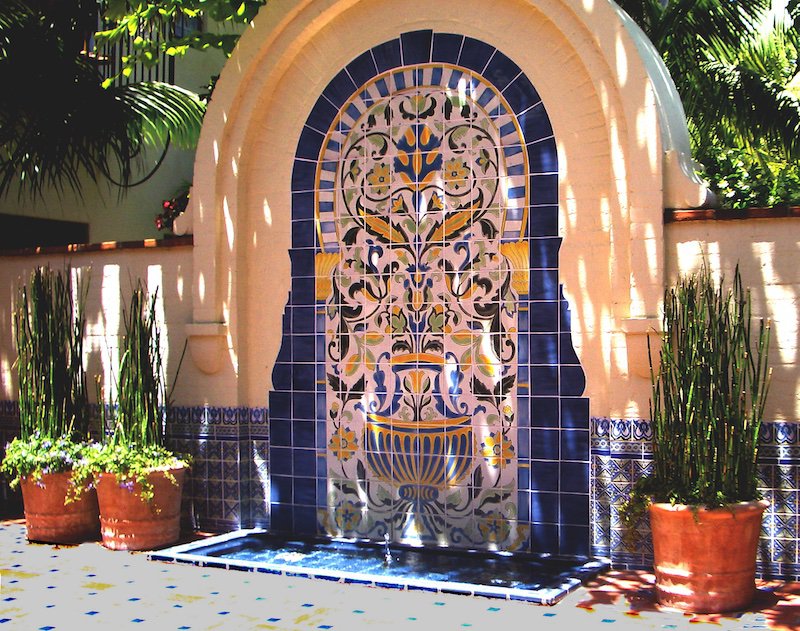

Fountain at Biltmore Santa Barbara.
by Joseph A. Taylor and Sheila A. Menzies, Tile Heritage Foundation
“There is nothing that adds to the cheerfulness and cleanliness of a house better than glazed tile.”
Rufus B. Keeler, Malibu Potteries
Among those who were fortunate enough early on was Robert (Bob) Harris, a sound technician in the movie business, who fancied a collector’s offer and purchased a sizable collection of original Malibu Potteries tile from this notable cache. Curiosity had taken hold of the man.
In 1979, Bob teamed up with Jim Sullivan, a recognized ceramist in Topanga Canyon, where the two men lived, – a few miles east of Malibu – to determine if the glazed tiles could be readily reproduced from scratch. The new company was named Malibu Ceramic Works.
Malibu Potteries wall panel at the Adamson Beach House, Malibu, Calif., with glazes developed by Superintendent Rufus B. Keeler. Architect: Stiles O. Clements, Morgan Walls & Clements in 1928-29.
Malibu Ceramic Works
Topanga, Calif.
Coincidentally, a few other tile collectors arranged an exhibition for these ceramic gems from the 1920s opening in 1980 at the Craft and Folk Art Museum in downtown Los Angeles. The result was a growing demand for ceramic tiles with designs and colors that reflected the vitality and brilliance of the 1920s and 1930s when the Malibu Potteries and other tile makers had flourished in Southern California.
Matt, Roz & Bob Harris of Malibu Ceramic Works.
Rather than Bob’s company attempting to replicate these famous tiles exactly, the goal at Malibu Ceramics was to provide architects, designers and their clients with a striking alternative to what was then offered in tile showrooms: tiles that reflected the ceramic traditions of California and provided the finest craftsmanship available at that time.
The kiln room at Malibu Ceramics.
Over the years the company has continued to specialize in custom work in addition to offering many of the historic Malibu patterns and designs as well as standard field tiles and trim shapes. What distinguishes Malibu Ceramic Works, and differentiates it from others, is that it was the first in the modern era to reproduce the now-famous Malibu and Catalina tiles from scratch, as handmade decorative tiles.
Join us in December as we explore the passion and career of artisans who worked for Bob, and then branched out and founded their own businesses.
Bob Harris making glaze in the lab.
Hugo at the glazing table.
Custom Decorative Octagon Fountain tile.
Private Residence, Pasadena, California.
Custom Pool, Fountain & Urns.
Santa Barbara, California.
TILE HERITAGE FOUNDATION
Guardian of American Tile History!
THF Legacy Giving
https://tinyurl.com/THFLegacyGiving
Tile Heritage Today
https://tinyurl.com/THF-Today
Relevance of Tile Heritage Today
https://tinyurl.com/THF-Relevance
THF Guardian of American Tile History https://tinyurl.com/THF-lnitiative

